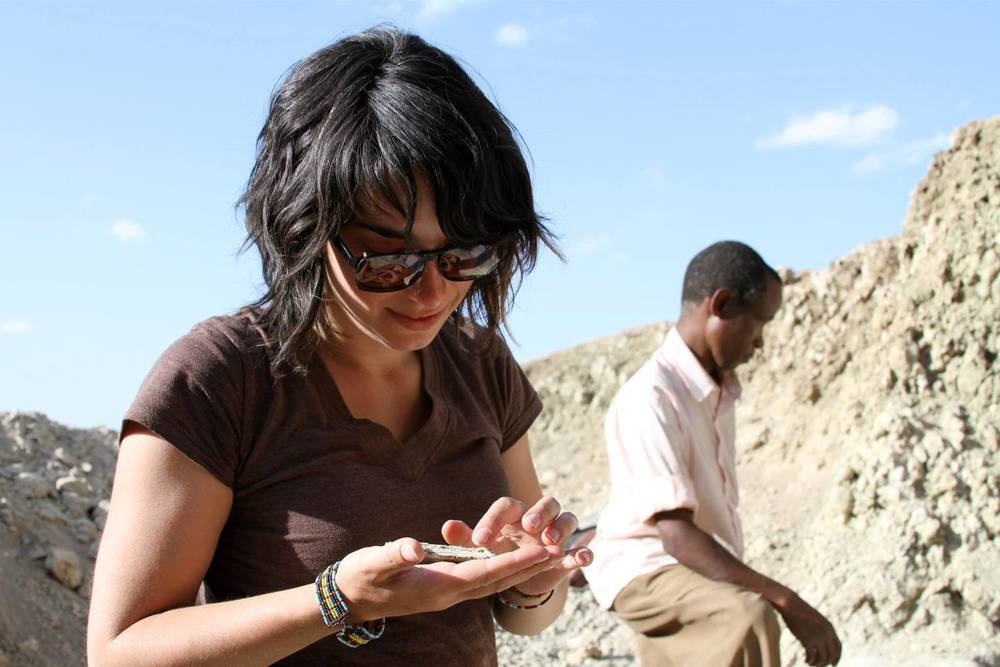From the Field
 Alia Gurtov at Olduvai Gorge, Tanzania.
Alia Gurtov at Olduvai Gorge, Tanzania.
This January we introduced you to fall 2014 grantee Alia Gurtov. Here she updates us on the progress of her project entitled “Dental microwear analysis of Early Pleistocene hominin foraging seasonality.”
I have long been interested in the ecological constraints on ancient human behavior. For my PhD research, I am studying the impact of seasonality on hominin foraging in the Early Pleistocene. By 2 million years ago in eastern Africa, the environment was periodically very similar to that of today, with a general trend toward aridity and dramatically different wet and dry season conditions. In this newly challenging seasonal cycle, early hominins faced adaptive pressure to modify their foraging behaviors to accommodate the changing distirbution of edible foods. It s also happens to be the first time we see hominins eating a substantial amount of meat. (Notably, this seasonal discrepency was remarked upon by Leakey Foundation Grantee Oliver Paine in the context of South African herbivores adjusting their diets to the few available foods in the dry season. You can read about it here.)
 Olduvai Gorge, seen from the top of Naibor Soit inselburg
Olduvai Gorge, seen from the top of Naibor Soit inselburg
Since 2011 I have worked at a site in Olduvai Gorge, Tanzania, called FLK North, which was initially excavated by Mary and Louis Leakey in the 1960s. Though it contains numerous stone tools, recent taphonomic studies indicate that its even more abundant faunal assemblage was primarily accumulated by carnivores, not hominins. In contrast, FLK Zinj, which is famous for producing the first Paranthropus boisei skull, aka Nutcracker Man, is a dense concentration of animal bones and stone tools with a key source of evidence connecting them: cut marks. FLK North and FLK Zinj have the same animals, stone tool technology, and paleoenvironment. As such, they provide a perfect opportunity to compare the meat foraging behaviors of hominins and carnivores in the highly seasonal context of the eastern African Early Pleistocene.
 Modern impala and Grant’s gazelles hanging out together near Lake Masek
Modern impala and Grant’s gazelles hanging out together near Lake Masek
With the support of the Leakey Foundation, I am now in the final stages of data collection, which I will complete in late August. In order to examine hominin foraging on a seasonal scale, I study the teeth of the animals they were eating, specifically the bovids Parmularius altidens and Antidorcas recki, both of which are abundant at FLK Zinj and FLK North. In a pilot study on modern impala, I demonstrated that the microscopic pits and scratches created by chewing differ significantly between wet and dry seasons, when impala are eating different foods (and different quantities of airborne grit!). Using the same approach, I can use a confocal microscope to analyze casts of bovids from Olduvai Gorge to see in which season they were eaten by hominins and FLK Zinj, and carnivores at FLK North.
 Alia Gurtov molding Parmularius altidens teeth
Alia Gurtov molding Parmularius altidens teeth
This February, 2015, I traveled to Nashville, TN, to work in The DeSantis DREAM Lab in the Earth and Environmental Sciences Department at Vanderbilt University. During the two weeks there, I analyzed dental microwear on tooth casts of extinct bovids from Olduvai Gorge. This process is one of intensive microscopy and statistical analysis, which required occasional hot chicken and live music breaks. By the end of the two weeks, I had weathered an ice storm, met future collaborators, and analyzed roughly 150 teeth.
 Parmularius altidens teeth at the National Museum in Dar es Salaam
Parmularius altidens teeth at the National Museum in Dar es Salaam
In June, I flew to Dar es Salaam, Tanzania, where the Louis and Mary Leakey fossil collections from Olduvai Gorge are stored. These fossils provide an inestimably valuable window into ancient hominin behavior and ecology in eastern Africa starting 1.9 million years ago. Because they have only recently been rehoused in Tanzania, part of my work at the museum included finding, organizing, and labeling the bovid assemblages from FLK North and FLK Zinj. Once done, I determined the minimum number of individuals represented by first and second molars among taxa of interest, including Parmularis altidens and Antidorcas recki. To this original sample, I added teeth excavated by The Olduvai Paleoanthropology and Paleoecology Project between 2008 – 2013. It was great to see some of these familiar fossil friends again. Once the associations between teeth were clear, I sampled all the undamaged first and second molars using Patterson dental impression paste, which forms vinyl molds capable of recording pits and scratches at the micron scale.

Immediately upon my return to Madison (that is, that very night!), I prepared the molds and cast them with Epotek 301 epoxy. I now eagerly await their curing so that I can finish analyzing them in Nashville this August.
To hear the end of the story, please join me at the 2016 American Association of Physical Anthropologists, where I plan to present my findings.
Click here for another update on Alia Gurtov’s project.


